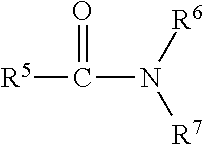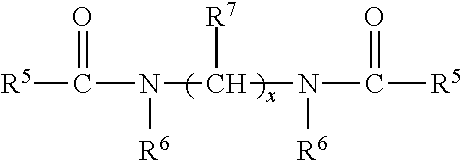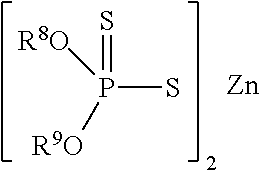Lubricating oil composition and additive therefor having improved wear properties
a technology of additives and lubricating oil, which is applied in the direction of additives, lubricant compositions, petroleum industry, etc., can solve the problems of restricting the maximum phosphorus levels of lubricants, and achieve the effect of increasing the phosphorus concentration and sufficient or improving wear performan
- Summary
- Abstract
- Description
- Claims
- Application Information
AI Technical Summary
Benefits of technology
Problems solved by technology
Method used
Image
Examples
example 1
Functionalized Dispersant
[0152]The functionalized dispersant used in the following experiments is described more fully in U.S. Patent Publication No. 2013 / 0040866, which is incorporated herein by reference. The set-up requires a 1 L 4-neck flask with agitator, addition funnel, temperature probe, temperature controller, heating mantle, Dean-Stark trap, and a condenser. The flask was charged with 2100 Mn polyisobutylene succinic anhydride (PIBSA) (195.0 g; 0.135 mole) and heated to 160° C. under a nitrogen blanket. Polyethylene amine mixture (21.17 g; 0.112 mole) was added drop-wise over 30 min. The reaction mixture was allowed to stir for 4 hours and then was vacuum stripped for 1 hour at 711 mm Hg. Process oil (172.0 g) was added and the mixture was stirred for 15 minutes. 1,8-Naphthalic anhydride (13.39 g; 0.068 mole) was added in one portion at 160° C. The reaction mixture was heated to 165° C. and allowed to stir for 4 hours. Vacuum was applied (711 mm Hg) for 1 hour to remove an...
example 2
[0154]In the following examples, the lubricating compositions contained the additives described in the table with the balance being Group II base oil. The wear scars of lubricant compositions were determined using a High Frequency Reciprocating Rig (HFRR). In the HFRR wear test, a steel ball immersed in the oil was oscillated across a steel disk at a speed of 20 Hz over a 1 mm path. A 7 Newton (about 1.0 GPa) load was applied between the ball and the disk and the tests were performed while holding the oil at 120° C. for one hour. After testing, a two-dimensional profile of the wear scar on the disk was determined. The cross-sectional area of the wear scar was reported and listed in the following table wherein the lower the value of the cross-sectional area, the better the anti-wear performance of the oil.
[0155]In Table 3, FM1 was oleamide and FM2 was glycerol monooleate (GMO). The ZDDP 1 was zinc dihydrocarbyl dithiophosphate derived from a primary alcohol, 2-ethylhexanol. The Dispe...
PUM
| Property | Measurement | Unit |
|---|---|---|
| molecular weight | aaaaa | aaaaa |
| molecular weight | aaaaa | aaaaa |
| temperature | aaaaa | aaaaa |
Abstract
Description
Claims
Application Information
 Login to View More
Login to View More - R&D
- Intellectual Property
- Life Sciences
- Materials
- Tech Scout
- Unparalleled Data Quality
- Higher Quality Content
- 60% Fewer Hallucinations
Browse by: Latest US Patents, China's latest patents, Technical Efficacy Thesaurus, Application Domain, Technology Topic, Popular Technical Reports.
© 2025 PatSnap. All rights reserved.Legal|Privacy policy|Modern Slavery Act Transparency Statement|Sitemap|About US| Contact US: help@patsnap.com



